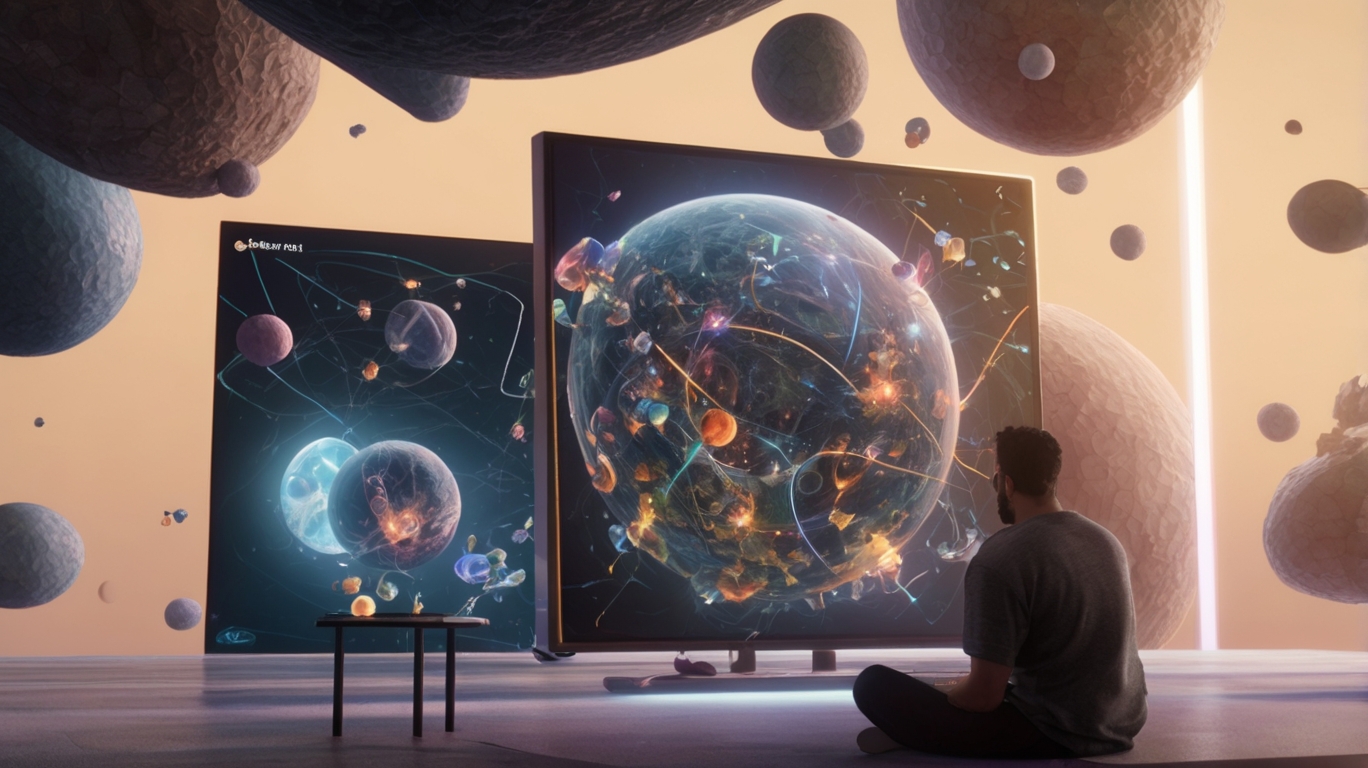Metaverse and Augmented Reality:
Not long ago, the concept of living, working, and playing in digital worlds seemed like something straight out of a science fiction novel. Today, those once-futuristic ideas are rapidly becoming our new reality. At the heart of this digital transformation are two groundbreaking technologies: the Metaverse and Augmented Reality (AR). Together, they’re reshaping how we interact with the digital world—and with each other.
But what exactly are these technologies? How do they work? And most importantly, how will they affect our daily lives, our workspaces, and our social interactions in the years to come?
Let’s dive deep into this immersive world and explore why the future of the internet might be closer than we ever imagined.
Understanding the Metaverse: More Than Just a Buzzword
The term “Metaverse” has surged in popularity in recent years, particularly after major tech giants like Meta (formerly Facebook), Microsoft, and Google began investing billions into building their versions of it. But what is the Metaverse?
In essence, the Metaverse is a collective, virtual shared space that is created by the convergence of virtually enhanced physical reality and the persistent virtual world. Think of it as the next iteration of the internet—an embodied internet where users, instead of just browsing content, are inside it.
Rather than clicking links and scrolling through feeds, users can walk through virtual environments, interact with 3D avatars, attend virtual concerts, shop in digital stores, and even buy virtual real estate. It’s an always-on, immersive, and interactive world that exists in parallel to our physical one.

Augmented Reality: Blending Digital with the Physical
While the Metaverse often brings to mind fully immersive virtual worlds experienced through headsets, Augmented Reality offers a different, yet equally transformative, experience. AR overlays digital information—such as images, animations, and data—onto the real world in real-time.
If you’ve ever used filters on Instagram or Snapchat, played Pokémon Go, or used your phone to see how furniture looks in your living room before buying it, you’ve experienced AR in action. But these are just the beginning.
AR is evolving fast. With the development of advanced AR glasses and wearable tech, users will soon be able to access digital information seamlessly without needing to look at their smartphones. Imagine walking down the street and seeing reviews pop up on restaurants, virtual signposts guiding your way, or having a real-time translator convert foreign signs instantly before your eyes.
How the Metaverse and AR Intersect
While the Metaverse and AR can exist independently, their true potential lies in their convergence. The immersive 3D environments of the Metaverse, when combined with the real-time overlay capabilities of AR, offer a powerful new dimension of interactivity and presence.
For instance, in a hybrid metaverse experience, you could be physically present in your living room while interacting with holographic coworkers during a virtual meeting. Or perhaps you’re attending a live concert with AR-enhanced visuals, where both virtual and real attendees coexist.
This fusion blurs the lines between digital and physical, creating what’s often referred to as mixed reality. It’s no longer just about escaping into a virtual world—it’s about enhancing and expanding the one we already live in.
Real-World Applications That Are Already Here
While full-scale Metaverse adoption might still be a few years away, many real-world applications of both AR and Metaverse principles are already in use today:
1. Education and Training
Imagine students walking through ancient Rome in history class or medical students practicing surgeries in lifelike simulations. AR and the Metaverse are revolutionizing learning by making it more interactive, engaging, and hands-on.
2. Remote Work and Collaboration
With more companies embracing remote work, virtual workspaces in the Metaverse offer a sense of presence and engagement that traditional video calls can’t match. Teams can brainstorm on virtual whiteboards, interact with 3D models, and hold meetings in virtual offices—no passport required.
3. Healthcare
From AR-assisted surgeries to therapy in virtual environments, healthcare is undergoing a quiet revolution. Surgeons can overlay patient data during operations, while therapists are using immersive environments to help patients cope with PTSD or phobias.
4. Shopping and E-Commerce
Virtual showrooms, AR fitting rooms, and digital storefronts are reshaping the retail experience. Shoppers can try on clothes virtually or visualize furniture in their homes before buying, reducing returns and increasing satisfaction.
5. Entertainment and Events
Concerts in the Metaverse, AR-enhanced sports broadcasts, and virtual film festivals are just the beginning. Artists and creators now have a global, limitless stage to perform and engage with fans.
Challenges and Ethical Considerations
As exciting as the Metaverse and AR are, they’re not without their challenges—and it’s important we address them early on.
1. Privacy Concerns
With AR and Metaverse environments tracking movement, behavior, and even biometric data, privacy becomes a pressing concern. Who owns this data? How is it used? And how do we ensure it’s protected?
2. Digital Addiction
Spending too much time in digital worlds can lead to disconnection from the physical one. Striking a balance between virtual immersion and real-life presence is essential for mental and emotional well-being.
3. Accessibility and Inequality
Not everyone has access to the technology required to participate in these digital environments. Ensuring inclusivity and affordability is key to preventing a digital divide in this new era.
4. Identity and Safety
As people create digital avatars and interact in virtual worlds, questions arise around identity, authenticity, and behavior. How do we handle harassment in the Metaverse? How do we verify identity in a world where appearances are customizable?
The Road Ahead: What’s Next for the Metaverse and AR?
The Metaverse and Augmented Reality are still in their early stages—but the pace of innovation is astonishing. According to market analysts, the global AR market is projected to reach over $100 billion by 2030, while Metaverse-related industries are attracting multi-billion-dollar investments.
Tech giants like Apple, Google, Meta, and Microsoft are racing to build the foundational infrastructure—devices, platforms, and ecosystems—that will power the next generation of the internet. Meanwhile, startups and independent creators are pushing boundaries, experimenting with new forms of digital expression and interaction.
In the not-so-distant future, we might see:
- Lightweight AR glasses replacing smartphones.
- Digital twins of cities used for urban planning and disaster response.
- Metaverse economies powered by blockchain and decentralized finance (DeFi).
- AI-driven virtual assistants integrated into AR interfaces, offering personalized help in real time.
This is not just a tech trend—it’s a cultural and societal transformation. The way we work, socialize, learn, and entertain ourselves is about to shift fundamentally.
Why This Matters: The Human Side of Innovation
At its core, the evolution toward the Metaverse and AR isn’t just about flashy tech—it’s about enhancing human connection. These tools have the power to bring people closer, foster creativity, and create new forms of expression and collaboration.
The Metaverse won’t replace the real world—it will enrich it. AR won’t detach us from reality—it will help us see it more vividly. The future of the internet isn’t some distant dream—it’s unfolding in real-time, and we’re all part of it.
Final Thoughts
The Metaverse and Augmented Reality are ushering in a new era—one where the digital and physical worlds are no longer separate, but intertwined. As we stand on the edge of this transformation, it’s important to approach it with curiosity, responsibility, and humanity.
We must ask not only what we can build—but why. What kind of digital world do we want to create? How can we use these tools to foster empathy, equality, and empowerment?
The future of the internet is not just a place—it’s an experience. And it’s closer than ever.
Are you ready to step into it?
Metaverse and Augmented Reality:
Frequently Asked Questions (FAQ)
1. What is the Metaverse?
The Metaverse is a collective virtual space where users can interact with a computer-generated environment and other users in real-time. It combines elements of virtual reality (VR), augmented reality (AR), and the internet to create immersive digital experiences.
2. How is Augmented Reality (AR) different from Virtual Reality (VR)?
AR enhances the real world by overlaying digital content onto your surroundings using devices like smartphones or AR glasses. VR, on the other hand, immerses users in a completely digital environment, often requiring a headset that blocks out the physical world.
3. How are the Metaverse and AR connected?
When combined, AR and the Metaverse create mixed reality experiences where users can interact with digital content in both fully virtual and real-world environments. This fusion allows for seamless transitions between physical and digital interactions.
4. What are some real-world applications of AR and the Metaverse?
These technologies are being used in various industries, including:
- Education: Virtual field trips and hands-on simulations.
- Healthcare: AR-assisted surgeries and VR therapy.
- Retail: Virtual try-ons and 3D product previews.
- Remote Work: Virtual offices and meetings in immersive spaces.
- Entertainment: Virtual concerts, gaming, and AR-enhanced sports broadcasts.
5. Are these technologies already available to the public?
Yes. While we’re still in the early stages of full Metaverse adoption, many AR and VR experiences are already accessible through apps, games, headsets, and AR-enabled devices.
6. What are the main challenges of the Metaverse and AR?
Some key concerns include:
- Privacy and data security
- Digital addiction and over-immersion
- Accessibility and inequality in tech access
- Online harassment and identity issues in virtual spaces
7. What devices do I need to access the Metaverse or use AR?
To access the Metaverse, you typically need a VR headset or a computer with compatible software. For AR, smartphones and tablets are commonly used, and AR glasses are becoming more available for hands-free experiences.
8. Will the Metaverse replace the real world?
No. The goal is not to replace reality but to enhance it. These technologies aim to enrich how we learn, work, and connect—by blending the digital and physical worlds in meaningful ways.
9. Is the Metaverse just for gaming?
Not at all. While gaming was one of the first major applications, the Metaverse now spans education, healthcare, business, social networking, real estate, and more.
10. How can I prepare for the future of the internet with AR and the Metaverse?
Start by exploring available AR apps, learning about VR platforms, and staying informed about technological trends. Consider how these tools could enhance your personal or professional life.
Read also :




